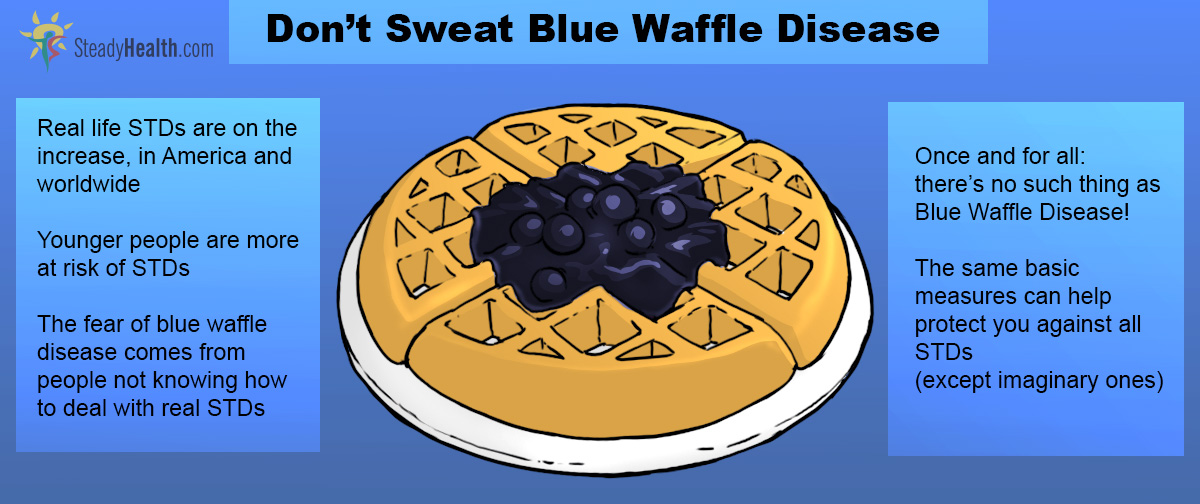"Blue waffle disease pictures" refer to images depicting an alleged sexually transmitted infection with blueish or purple discoloration and swelling around the genital area.
However, no medical evidence supports the existence of such a condition, and the term is primarily found in hoax emails and scare tactics.
Despite its fabricated nature, "blue waffle disease" has gained notoriety due to its graphic and disturbing nature. The spread of these images can instil fear and anxiety, highlighting the importance of accurate health information and the dangers of online misinformation.
In this article, we will explore the origins, impact, and preventive measures associated with "blue waffle disease" pictures, emphasizing the crucial role of responsible online behaviour.
blue waffle disease pictures
Understanding the essential aspects of "blue waffle disease pictures" is crucial for combating misinformation and promoting accurate health knowledge.
- Hoax: No medical basis
- Misinformation: Spread through scare tactics
- Fear and anxiety: Negative psychological impact
- Online safety: Importance of responsible behavior
- Health literacy: Empowering individuals with accurate information
- Media influence: Role in shaping perceptions
- Cyberbullying: Potential weapon for harassment
- Public health: Importance of reliable sources
These aspects underscore the need for critical thinking, media literacy, and collaboration among individuals, healthcare professionals, and policymakers to address the issue of "blue waffle disease" pictures effectively. By raising awareness about these aspects, we can foster a more informed and responsible online environment that prioritizes truth and well-being.
Hoax
The connection between "hoax: no medical basis" and "blue waffle disease pictures" is deeply intertwined, with the former being a defining characteristic of the latter. The absence of any genuine medical foundation renders "blue waffle disease" a complete fabrication, existing solely within the realm of scare tactics and online misinformation.
This fictitious nature has profound implications, as it allows the spread of unfounded fear and anxiety, potentially leading to unnecessary distress and harmful actions. The lack of medical basis undermines the credibility of "blue waffle disease" pictures, exposing them as a hoax designed to deceive and manipulate. Real-life examples abound, with individuals falling prey to online scams or experiencing cyberbullying due to the proliferation of these fabricated images.
Understanding this connection is crucial for combating misinformation and promoting accurate health knowledge. By recognizing the absence of any medical basis for "blue waffle disease" pictures, we can effectively debunk these hoaxes, preventing their further spread and safeguarding individuals from their potential negative consequences. This understanding empowers us to critically evaluate online health information, rely on credible sources, and promote responsible online behaviour.
Misinformation
The malicious intent behind "blue waffle disease pictures" goes beyond mere fabrication, as they are often deliberately employed as a means to spread misinformation through scare tactics. This strategy exploits people's fears and vulnerabilities to manipulate their behaviour and perpetuate false narratives.
- Emotional Manipulation
These images evoke intense emotions of disgust, fear, and anxiety, which can cloud judgment and make individuals more susceptible to misinformation.
- Viral Propagation
The graphic and shocking nature of these pictures makes them highly shareable on social media and online forums, contributing to their rapid and widespread dissemination.
- False Health Information
The circulation of these pictures perpetuates unfounded health claims and promotes irrational fears about non-existent sexually transmitted infections.
- Cyberbullying and Harassment
In some cases, these images are weaponized for cyberbullying or harassment, causing severe emotional distress and reputational damage to victims.
These scare tactics not only deceive individuals but also undermine trust in credible health information sources. They create a climate of fear and uncertainty, making it difficult for people to make informed decisions about their health. Recognizing and countering these tactics is crucial for promoting accurate health knowledge and protecting individuals from the harmful consequences of misinformation.
Fear and anxiety
The connection between "fear and anxiety: negative psychological impact" and "blue waffle disease pictures" is profound and deeply concerning. These fabricated images are deliberately crafted to evoke intense emotions of disgust, fear, and anxiety, which can have severe psychological consequences.
The fear instilled by these images stems from the false belief that "blue waffle disease" is a real and highly contagious sexually transmitted infection. This fear can lead to excessive worry, avoidance of sexual activity, and relationship problems. Anxiety can manifest as racing thoughts, difficulty sleeping, and physical symptoms such as sweating and trembling.
Real-life examples abound of individuals who have experienced significant psychological distress due to exposure to "blue waffle disease pictures." Some have reported feeling ashamed, embarrassed, and isolated. Others have sought unnecessary medical attention or engaged in risky sexual behaviour out of fear of contracting the non-existent disease.
Understanding the connection between "fear and anxiety: negative psychological impact" and "blue waffle disease pictures" is crucial for several reasons. Firstly, it allows us to recognize and debunk the misinformation that perpetuates these images. Secondly, it empowers us to support individuals who may have been affected by these images and provide them with accurate health information. Finally, it highlights the need for ongoing efforts to combat misinformation and promote responsible online behaviour.
Online safety
In the context of "blue waffle disease pictures," understanding the crucial connection between "Online safety: Importance of responsible behavior" and "blue waffle disease pictures" is paramount. The spread of these fabricated images hinges on the concept of online safety, emphasizing the need for responsible behavior to mitigate their harmful effects.
Firstly, the lack of online safety exposes individuals to the risk of encountering these images, often without their consent. This can lead to feelings of shock, disgust, and fear, especially among those unaware of their fictitious nature. By promoting responsible online behavior, such as exercising caution when clicking on unfamiliar links or downloading attachments, individuals can reduce their vulnerability to such content.
Secondly, responsible online behavior empowers individuals to challenge and report instances of "blue waffle disease" pictures. By actively flagging and reporting this type of content to relevant platforms or authorities, individuals can help prevent its proliferation and protect others from potential harm. Real-life examples of individuals who have successfully reported and taken down such images demonstrate the positive impact of responsible online behavior.
In conclusion, the relationship between "Online safety: Importance of responsible behavior" and "blue waffle disease pictures" highlights the critical role of online safety in safeguarding individuals from misinformation and its psychological consequences. By fostering a culture of responsible online behavior, we can effectively combat the spread of harmful content and create a safer and more informed online environment.
Health literacy
In the context of "blue waffle disease pictures," understanding the relationship between "Health literacy: Empowering individuals with accurate information" and "blue waffle disease pictures" is crucial. Health literacy encompasses the ability to find, understand, and use health information and services to make informed decisions about one's health.
When individuals are equipped with adequate health literacy, they are better equipped to critically evaluate health information, recognize misinformation, and make informed choices regarding their health. In the case of "blue waffle disease pictures," health literacy empowers individuals to identify these images as a hoax, avoiding unnecessary fear and anxiety.
Real-life examples underscore the significance of health literacy in combating misinformation. For instance, individuals who have received comprehensive sex education and have access to reliable health information sources are less likely to fall prey to scare tactics surrounding "blue waffle disease" pictures. By fostering health literacy, we can empower individuals to navigate the vast amount of health information available online and make informed decisions about their health.
In conclusion, the connection between "Health literacy: Empowering individuals with accurate information" and "blue waffle disease pictures" highlights the critical need for health literacy in combating misinformation and promoting informed health choices. By equipping individuals with the knowledge and skills to evaluate health information critically, we can create a more informed and health-conscious society.
Media influence
The connection between "Media influence: Role in shaping perceptions" and "blue waffle disease pictures" cannot be overstated. The media plays a pivotal role in shaping public opinion and disseminating information, and this influence extends to the realm of health and medicine.
In the case of "blue waffle disease" pictures, the media's portrayal of these fabricated images has significantly shaped public perceptions. The graphic and disturbing nature of these pictures has led to widespread fear and anxiety, despite the fact that there is no medical basis for the condition. This fear and anxiety has been further amplified by sensationalized media coverage that perpetuates the myth of "blue waffle disease" as a real and dangerous sexually transmitted infection.
Real-life examples abound of the media's influence on shaping perceptions surrounding "blue waffle disease" pictures. In one instance, a young woman was subjected to online harassment and bullying after an image of her was falsely circulated as a "blue waffle disease" picture. This incident highlights the devastating impact that misinformation and media sensationalism can have on individuals' lives.
Understanding the connection between "Media influence: Role in shaping perceptions" and "blue waffle disease pictures" has several practical applications. Firstly, it underscores the importance of media literacy and critical thinking skills. By equipping individuals with the ability to evaluate media messages critically, we can empower them to resist misinformation and make informed decisions about their health.
Secondly, it highlights the need for responsible reporting by the media. Media outlets have a responsibility to report on health issues accurately and responsibly, avoiding sensationalism and fear-mongering. By adhering to ethical guidelines and promoting evidence-based information, the media can play a positive role in shaping public health knowledge and behaviour.
Cyberbullying
Within the realm of "blue waffle disease pictures," the aspect of "Cyberbullying: Potential weapon for harassment" takes on a sinister dimension. These fabricated images are often weaponized to inflict emotional distress and reputational damage upon unsuspecting individuals, highlighting the urgent need to understand and combat this malicious practice.
- Emotional Manipulation
Cyberbullies may use these images to evoke fear, shame, and humiliation, causing significant emotional distress to victims. The explicit and graphic nature of these pictures can be particularly harmful, as they can trigger feelings of disgust and revulsion.
- Identity Theft
In some cases, cyberbullies may attach the victim's personal information or images to "blue waffle disease" pictures, creating a false association between the victim and the fictitious disease. This can lead to severe reputational damage and social stigma.
- Online Stalking
Cyberbullies may use "blue waffle disease" pictures as a means to stalk victims online, repeatedly sending them these images and threatening to share them with others. This persistent harassment can cause victims to feel isolated and unsafe.
- Extortion
Cyberbullies may attempt to extort money or other favours from victims by threatening to release "blue waffle disease" pictures or spread false rumours about them. This type of cyberbullying can have severe financial and emotional consequences.
The proliferation of "blue waffle disease pictures" has exacerbated the problem of cyberbullying, as these images provide cyberbullies with a readily available and highly effective means to inflict harm. It is crucial for individuals to be aware of this potential weapon of harassment and to take steps to protect themselves and others from its harmful effects. By reporting cyberbullying, supporting victims, and promoting responsible online behaviour, we can create a safer and more respectful online environment.
Public health
In the context of "blue waffle disease pictures," understanding the "Public health: Importance of reliable sources" is paramount for combatting misinformation, promoting accurate health knowledge, and protecting individuals from its potential negative consequences.
- Accurate Health Information
Reliable sources provide scientifically accurate and evidence-based health information, debunking the myths and misinformation surrounding "blue waffle disease" and empowering individuals to make informed health decisions.
- Prevention of Misinformation
By promoting reliable sources and fostering critical thinking, we can prevent the spread of misinformation and protect individuals from falling prey to unfounded fear and anxiety.
- Protection from Cyberbullying
Reliable sources can help individuals identify and report instances of cyberbullying involving "blue waffle disease" pictures, ensuring a safer and more respectful online environment.
- Promotion of Health Literacy
Access to reliable sources fosters health literacy, equipping individuals with the skills to critically evaluate health information, navigate the vast amount of health information available online, and make informed choices about their health.
In conclusion, reliable sources are crucial for safeguarding public health in the face of misinformation surrounding "blue waffle disease pictures." By promoting evidence-based health information, preventing the spread of misinformation, protecting against cyberbullying, and fostering health literacy, we can create a more informed and responsible society.
Our exploration of "blue waffle disease pictures" has unveiled the malicious intent behind these fabricated images, their negative psychological impact, and their potential to fuel cyberbullying and harassment. We have also emphasized the importance of online safety, health literacy, media literacy, and reliable sources in combating misinformation and safeguarding public health.
Understanding the interconnections between these key points is crucial. Misinformation thrives in environments where individuals lack critical thinking skills and access to reliable health information. Cyberbullying often exploits the fear and anxiety caused by misinformation, further victimizing individuals. Media literacy empowers individuals to critically evaluate health information and resist sensationalism, while reliable sources provide accurate and evidence-based health knowledge. These elements are intricately linked and essential for promoting a healthy and informed society.
In conclusion, recognizing the fabricated nature of "blue waffle disease pictures" and understanding the malicious intent behind their spread is paramount. By fostering critical thinking, promoting reliable sources, and encouraging responsible online behaviour, we can effectively combat misinformation, protect individuals from its harmful consequences, and create a more informed and responsible society.
Ultimate Guide To Taylor Swift Concert Seating Charts
Unlock The Power Of 4G: Supercharge Your Mobile Experience
How Lee Asher's Wife Supports His Musical Journey: A Closer Look



ncG1vNJzZmicpZuur3rApqpsZpSetKrAwKWmnJ2Ro8CxrcKeqmebn6J8o7jUnmSwmZabuaZ5w6KqnpmjmnqxtcKtrKudo2O1tbnL